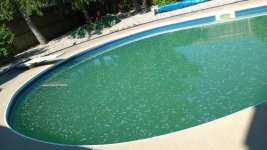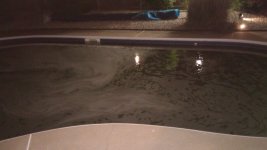Well, we seem to have different opinions on the water situation, at least from a TFP perspective. While I can't say for sure what these gray spots are from, we can't rule out chemistry 100% just yet. But based on your last reply, I will offer you the following info for consideration:
- "
Both combined and free chlorine are kept high". That's not good (CC) and questionable (FC). CCs should never be elevated over 0.5. If they are there's an organic overload or oxidation problem. As for FC being high, how high exactly? And compared to what CYA at the moment. If your CYA happened to be 40 for example, you could easily have an FC of 16 with no problem (SLAM level). See the
FC/CYA Levels for the FC to CYA relationship.
- "
Also, making sure that the pH and Total Alkalinity is optimum". What numbers exactly? Probably has no bearing on these gray spots, but the exact pH and TA would be good to know.
- "
I added a quart of “Pool Mate Filter Cleaner”. We'll need to research the SDS on that one to find out what its all about. We don't recommend adding anything to sand other than water during a deep cleaning process.
-
"I added CYA directly to the basket of the skimmer". Never do that. Too acidic and can easily plug your suction line. Always pre-soak the stabilizer in a sock for about 30 min then squeeze it all out.
- "
I do check the pool water with the Taylor kit". IMO, that is key right there.
- "
the gauge gives constant readings of about 19PSI whenever the pump is running". That seems a bit high which would be indicative or excessive organics. What is the psi after a backwash?
- "
whenever I backwash the sand filter water squirts and leaks out of the sight glass". That will need to be addressed. When the system is off, air could be pulled "IN" messing with what should be an airtight plumbing system.
- "
I want address the sand filter situation before adding more expensive chemicals and superchlorinating the pool again". Certainly your choice, but remember sand doesn't go bad, so unless a bad pool store chemical was added to make it bad, there's not much to do with the sand filter other than perhaps a sand deep cleaning with water.
Looking back at this thread, several seasoned members/experts here at TFP have emphasized the importance of using a proper test kit and considering the need to perform a
SLAM Process to ensure any heavy organic load is killed/removed. This is not a simple pool store term of super-chlorination, but a consistent process of maintaining the proper elevated FC level that gives the free chlorine ample time to kill and remove the algae or any other product that may be in the water. We can only advise though. We can't make anyone on TFP buy a kit or employ the advice we offer, but we certainly recommend it. Before you invest too much more time in the filter, I do think you should consider these recommendations. You might be surprised of the results.






